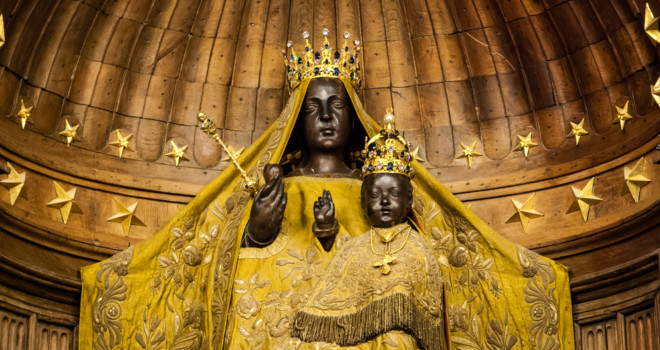In the year 1665 a young scientist at Cambridge University by the name of Isaac Newton took a glass prism and placed it in the path of a sunbeam. The white light scattered into an array of the seven colors of the rainbow. Newton showed that white light is not simply white light but an aggregation of many colors. This simple but historical experiment bears an interesting analogical relationship with Mary the Mother of God who is often compared with the sun (she is Clothed with the Sun) and yet can be refracted into a multitude of faces.
On October 13, 1917, before a gathering of an estimated 70,000 people in Fatima, Portugal, the “miracle of the sun” took place. Some witnesses attested not only to the extraordinary movement of the sun (which lasted for about ten minutes), but that its light dispersed into many different colors. The sun, therefore, served as a kind of prism that displayed itself as a multi-colored reality. According to a reporter for the Lisbon newspaper O Dia, “The light [of the sun] turned a beautiful blue, as if it had come through the stained-glass windows of a cathedral, and spread itself over the people who knelt with outstretched hands . . . people wept and prayed with uncovered heads, in the presence of a miracle they had awaited”.
The display of many colors may be taken to symbolize the many faces of Mary. Mary is not one color, that is to say, restricted to being a member of a particular race, but is many-colored, indicating that she can be identified with all races. This is a most important point, since, in today’s eagerness to find racism everywhere, Mary is sometimes seen as belonging only to a race of white people. This is an extremely myopic way of understanding the Mother of God. To take but one example, the CEO of a Catholic Charities organization in the United States has stated that “My Catholic Church, and my Catholic Charities organization, is racist. How could they not be? Our Catholic faith tradition is built on the premise that a baby, born in a manger in the Middle East, was a white baby”. By implication, Mary is indicted for the same reason. How does a Catholic who serves an important function in the Church remain so egregiously ignorant of his own religion? If a person is a racist simple because his skin has color, then everyone is a racist! And yet, this CEO denies he is a racist, though he imputes that vice to all other Catholics.
Mary is the model of humility, as she states in her Magnificat: “He has looked with favor on his humble servant”. But in the very next line she states that “From this day all generations will call me blessed” (Luke 1:46). Commenting on this passage, Bishop Fulton Sheen remarks that “this woman looks down the long corridors of time [and sees] there the unknown people of Africa, Asia, China, Japan . . .” Both historically and geographically, Mary is for everyone. Her motherhood knows no limitation.
History has dramatically informed us of the universality of Mary. The image of Our Lady of Guadalupe on the tilma of Juan Diego shows her to be Mexican. She has appeared to her children not only in Portugal and Mexico, but in France, Ireland, Poland, Lithuania, Italy, Rwanda, Japan, Viet Nam, Peru, Ecuador, Belgium, as well as in the United States. The Black Madonna is revered in dozens of countries, the best known being the Black Madonna of Czestochowa where the figure of both Mary and the Child Jesus are depicted in black. In a Marian liturgy we find the words “Nigra sum sed formosa” (“I am black, and I am beautiful”), words taken from the Song of Solomon with regard to the Queen of Sheba. G. K. Chesterton has superbly captured the multi-faced universal quality of Mary in his poem, “The Black Virgin”. The last stanza of this ten stanza rhyme is cited as follows:
In all thy thousand images we salute thee,
Claim and acclaim on all thy thousand thrones
Hewn out of multi-colored rocks and risen
Stained with the stored-up sunsets in all tones-
If in all tones and shades this shade I feel,
Come from the black cathedrals of Castille
Climbing these flat black stones of Catalonia,
To thy most merciful face of night I kneel.
In the fifth stanza of the poem, Chesterton states that “Starlight and twilight” are “refractions” of Mary. The word ‘refraction” leads us back to Sir Isaac Newton and his refracting sunlight into all the colors of the rainbow. Just as, in a scientific sense, sunlight is composed of many colors, so too, Mary, in a theological sense, is the Sun that portrays many faces. We should see Mary in her transparency. Then, we will begin to see her in her omnificent reality.
✠
image: Statue of Black Madonna with Child in Chartres cathedral, Elena Dijour / Shutterstock













